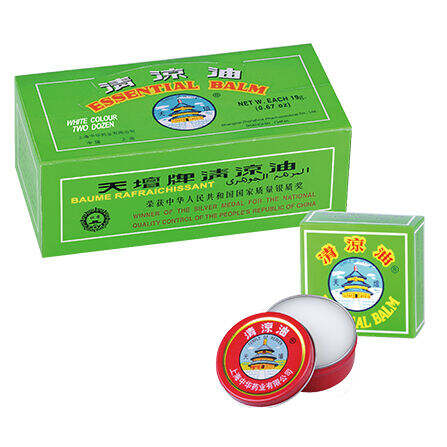Domy tajlandzkich społeczności rolniczych, ciasno upakowane apartamenty w Singapurze, zatłoczone ulice Hongkongu oraz wiele, wiele innych miejsc pomiędzy nimi – każde z nich to miejsce, gdzie niewielki, ale bardzo szczególny słoik w czerwono-białą kratkę zyskuje znaczenie daleko wykraczające poza swoja wielkość. Tiger Balm to znak rozpoznawczy kultury, kamień milowy pokoleń dzielony przez tysiące ludzi i przykład udanej wierności marki w tym samym stopniu, co obecność i niezawodność.
Można poczuć jego obecność kulturową. Pachnący zapach, znana tekstura maści oraz nieomylna słoikowa forma, które można znaleźć w torebce babci lub w apteczce, wystarczy wspomnieć przy okazji Balsamu Tygrysiowego, by wywołać u wielu Azjatów silne skojarzenia sensoryczne. To nie jest po prostu produkt, lecz nieodłączny element codziennych spraw i rodzinnego opiekuństwa. Korzystanie z niego może być kojącym rytuałem – rodzic pocieszającym dziecko, kolega z pracy złagodzeniem stresowego dnia, podróżnikiem przygotowującym się do wyprawy. Tak głębokie przeniknięcie w codzienne nawyki i zachowania opiekuńcze czyni z niego markę i kulturowy stan dobrostanu oraz wspólnoty.
To na tym obecności kulturowej opiera się jego fenomenalna rozpoznawalność marki. Graficzny obraz, intensywny czerwony tło, potężny logo tygrysa, wyraźny biały tekst – wydaje się znajomy nawet na poziomie powierzchniowym i jest jednym z najłatwiej rozpoznawalnych logo w regionie. Nie trzeba tego tłumaczyć. Gdy ktoś zobaczy tę słoik na półce apteki lub w sklepie spożywczym, albo w ręku osoby, następuje natychmiastowe rozpoznanie. Nie jest to jedynie bierna identyfikacja, nasycona jest dziesięcioleciowymi skojarzeniami: zaufanie, tradycja, natychmiastowe fizyczne rozpoznanie, uspokajająca gwarancja znanego rytuału. Jest to lokalna, zrozumiała i zaufana marka, niezależnie od kraju na zróżnicowanym terytorium Azji.
Jest to coś, co wzmocniła widoczność marki. Maść Tygrysia jest niemal wszędzie w Azji, zarówno w tradycyjnych, jak i nowoczesnych kanałach sprzedaży detalicznej. Jest dostępna w najstarszych aptekach rodzinnych (tzw. sklepikach „mama papa”), które sprzedają ją od lat 60., po jasno oświetlone półki sklepów wolnocłowych na lotniskach międzynarodowych i nowoczesne ściany dużych sieci supermarketów. Taka powszechna dostępność nie jest jedynie kwestią logistycznego zasięgu, ale przyczynia się do umacniania trwałej obecności marki w społeczności, do jej stabilności. Marka ta stoi, zawsze jest obecna, w szybko zmieniającym się świecie.
Ponadto Maść Tygrysia bez trudu znajduje swoje miejsce w codziennych praktykach społecznych regionu. Żaden zestaw podróżny nie jest kompletny bez niej, jest to przedmiot, który często zabiera się do domu jako upominek po wizycie w innym kraju (przynajmniej duże, charakterystyczne pudełka), a w biurach i domach może być dzielona z innymi. Taki sposób rozpowszechniania czyni ją naturalną i znacznie zwiększoną. Dzielenie się słoikiem staje się formą odpowiedzialności społecznej, co dodatkowo wpisuje ją w dyskurs społeczny i podnosi poziom rekomendacji marki między ludzi.
Inną siłą marki jest jej duża elastyczność, która równocześnie nie narusza jej oryginalności. Mimo silnych korzeni w tradycji, obecność marki w nowoczesnych kontekstach, takich jak eleganckie punkty sprzedaży w lotniskach, różnorodność wersji opakowań zarówno w kontekście współczesnym, jak i retro, czy też zastosowanie w systemach dobrostanu miejskiego, nadaje jej cechy współczesne, nie naruszając bazy użytkowników, która pozostaje głęboko osadzona w tradycyjnej kulturze. Taka równowaga między tradycją a nowoczesnością jest kluczowa dla utrzymywania znaczenia z pokolenia na pokolenie.
Podsumowując, Tiger Balm nie musi wiele mówić, aby odnieść wielki sukces na rynku azjatyckim, ponieważ historia marki stającej się częścią kultury stanowi wystarczająco mocny argument. Jej niezrównana rozpoznawalność, wynikająca z wizerunku koncepcyjnego i ponad czterdziestoletniej obecności na rynku, nie może być omawiana poza kontekstem pełnego zakorzenienia się w codzienne życie, życie rodzinne i percepcję zmysłową Azjatów. Jest to marka, która nie tylko wpływa na wzrok czy nawet węch, ale także rezonuje w sercach odbiorców, wywołując specyficzne poczucie uduchowionej atrakcyjności, które pozostaje trwałe. Mała czerwono-biała pojemność stała się ikoną, całkowicie rozpoznawalną i łatwo przenikającą życie ludzi azjatyckich.

 EN
EN AR
AR HR
HR CS
CS NL
NL FR
FR DE
DE EL
EL HI
HI IT
IT JA
JA KO
KO PL
PL PT
PT RO
RO RU
RU ES
ES SV
SV TL
TL IW
IW ID
ID SR
SR UK
UK VI
VI HU
HU TH
TH TR
TR FA
FA AF
AF MS
MS KA
KA BN
BN GU
GU LA
LA MY
MY KK
KK MG
MG UZ
UZ





